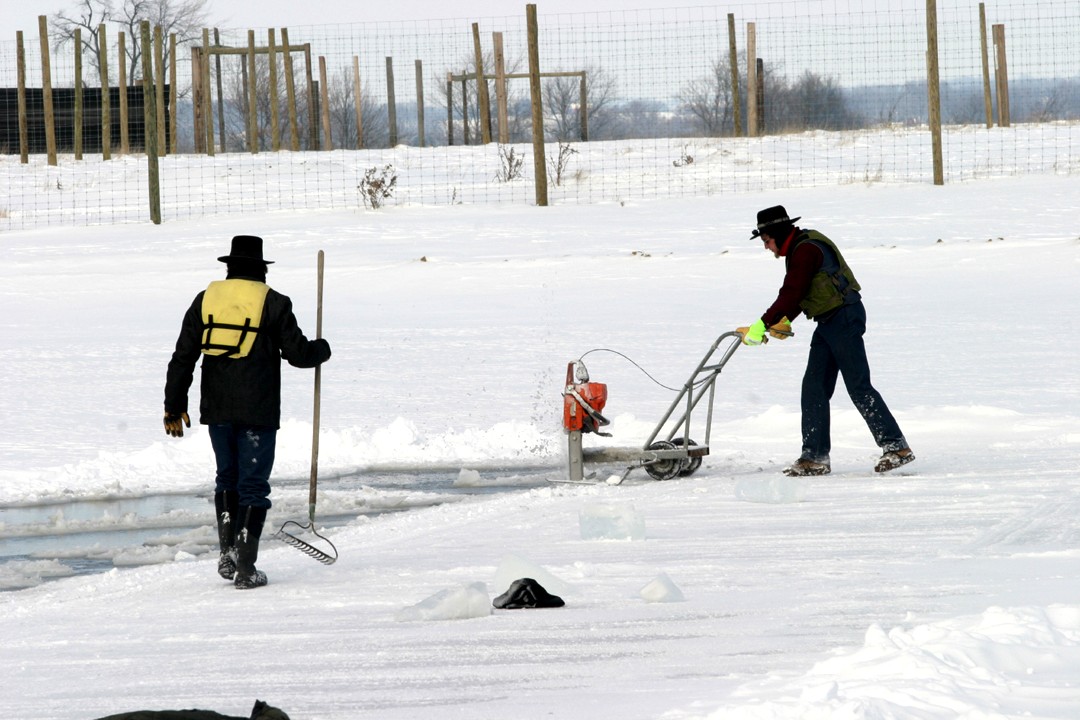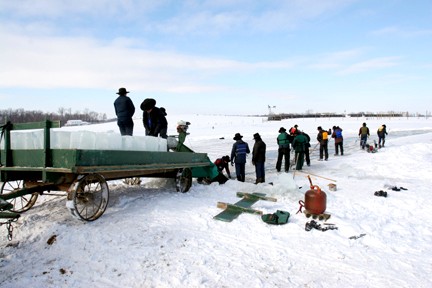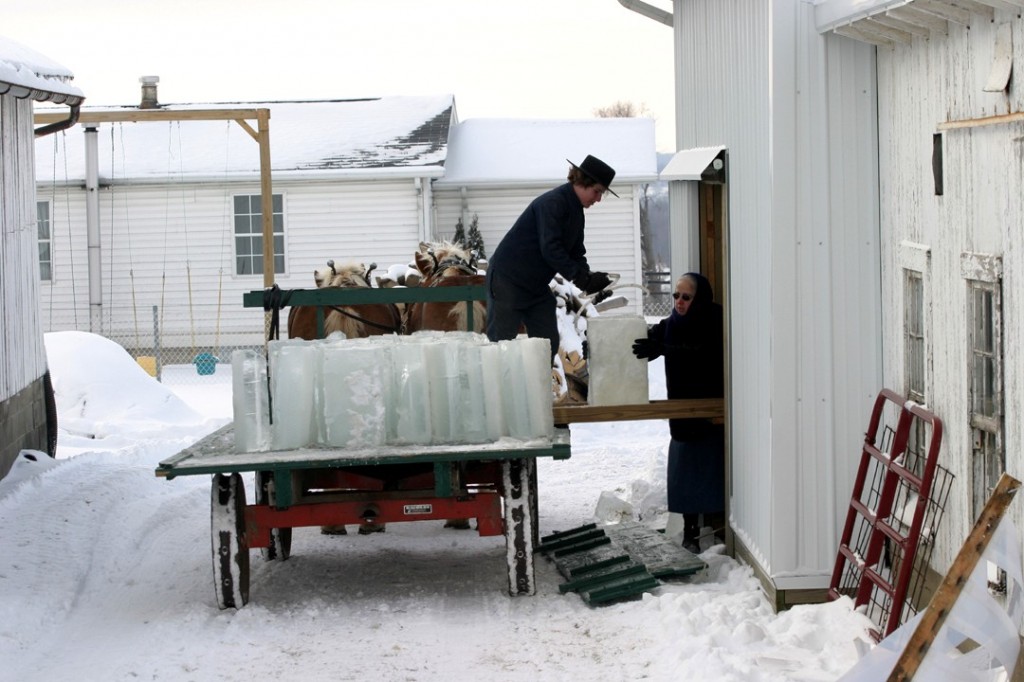By Francis Woodruff, Editor and Publisher, The Dalton Gazette & The Kidron News
Reprinted with Permission
When temperatures drop below zero in the wintertime, there are few outside activities that many of us can do. But for several Amish families this weather presents the perfect conditions to cut, pack, and store ice in their ice houses for the coming summer months. The Amish, who live without electricity, use the ice for food refrigeration.
Recently, Joe Miller watched as his son David J. Miller and his family slid the heavy blocks of ice down a wooden plank board into a room designed for ice storage. “This is perfect weather for cutting ice,” Joe Miller said. “The colder the better.” He explained the colder it is when the ice goes into the storage room the better, because it stays colder longer. In addition to refrigeration, the room can also be used to freeze other foods, he said – like a giant freezer.
David J. and his father Joe both live on Harrison Road about 5 miles south of Kidron, and several Fridays ago was ice cutting day as the temperature hovered around 10-below zero. David had recently built a new home on his farm and made a special room in the basement for ice storage so he would not have to go outside to bring in ice when needed. The walls of the 8-foot by 10-foot room are lined with 32-inch thick Styrofoam insulation and will keep the ice cold throughout the hot summer. Blocks of ice are stacked solid to the ceiling in the room. A family member said they change ice in their  kitchen ice box about twice a week in the summer months.
kitchen ice box about twice a week in the summer months.
The ice blocks were being cut about 4 miles away on Salt Creek Road at the David H. Miller farm where there is a small pond. The small group of men on the pond didn’t seem to mind the bone-chilling cold, as their breath hung in the frosty air and ice clung to their beards. One man had the job of sitting on the ice with his feet in the frigid water, helping push ice blocks onto a motorized conveyor. He wore insulated waist-high wader boots and said he didn’t feel the cold water but felt the cold more when he came out of the water as the frigid wind iced up the boots.
The process begins by cutting the ice into blocks weighing around 50 pounds. This ice from the fr ozen pond has a thickness of around 11 inches. To actually cut through the pond, a chain from a chainsaw is custom made into a specific type of blade which is powered by a gas engine by way of a belt. The ice blocks are then floated and pushed by poles to the edge of the pond where they go up a small conveyor machine to load onto horse-drawn wagons or wagons pulled by tractors. Clarence Steiner of Apple Creek loaned his large John Deere tractor and wagon to haul the ice the four miles to the David Miller farm. The men estimated approximately 10 tons of ice were loaded onto each wagon. The horse-drawn wagons traveled only a short distance with their heavy load to deliver ice to fill neighbors’ ice houses. Four families shared in the ice harvest on this one day, since ice harvesting is done just once a year. The ice house on the David H. Miller farm was just up the hill from the pond but also had the 32-inch thick walls.
ozen pond has a thickness of around 11 inches. To actually cut through the pond, a chain from a chainsaw is custom made into a specific type of blade which is powered by a gas engine by way of a belt. The ice blocks are then floated and pushed by poles to the edge of the pond where they go up a small conveyor machine to load onto horse-drawn wagons or wagons pulled by tractors. Clarence Steiner of Apple Creek loaned his large John Deere tractor and wagon to haul the ice the four miles to the David Miller farm. The men estimated approximately 10 tons of ice were loaded onto each wagon. The horse-drawn wagons traveled only a short distance with their heavy load to deliver ice to fill neighbors’ ice houses. Four families shared in the ice harvest on this one day, since ice harvesting is done just once a year. The ice house on the David H. Miller farm was just up the hill from the pond but also had the 32-inch thick walls.
A small heated shed located near the pond was used frequ ently by the men to get an occasional warm-up and a quick cup of coffee and cream stick for energy.
ently by the men to get an occasional warm-up and a quick cup of coffee and cream stick for energy.
The colder weather is also good for handling and stacking the ice, one man explained. As the ice comes out of the pond, the water dripping off instantly freezes and makes handling it easier and no sawdust is needed to keep the ice from sticking together when stacked in the ice house.
By three o’clock, the four ice storage rooms were almost filled and the sun was setting on another successful ice harvest.
Editor’s Note: First posted in March 2009.

































[…] which they fill in the wintertime with block ice cut from local ponds or lakes (see more photos of this fascinating process!). While that ice can last several months, by the hot summer months an alternative is often […]